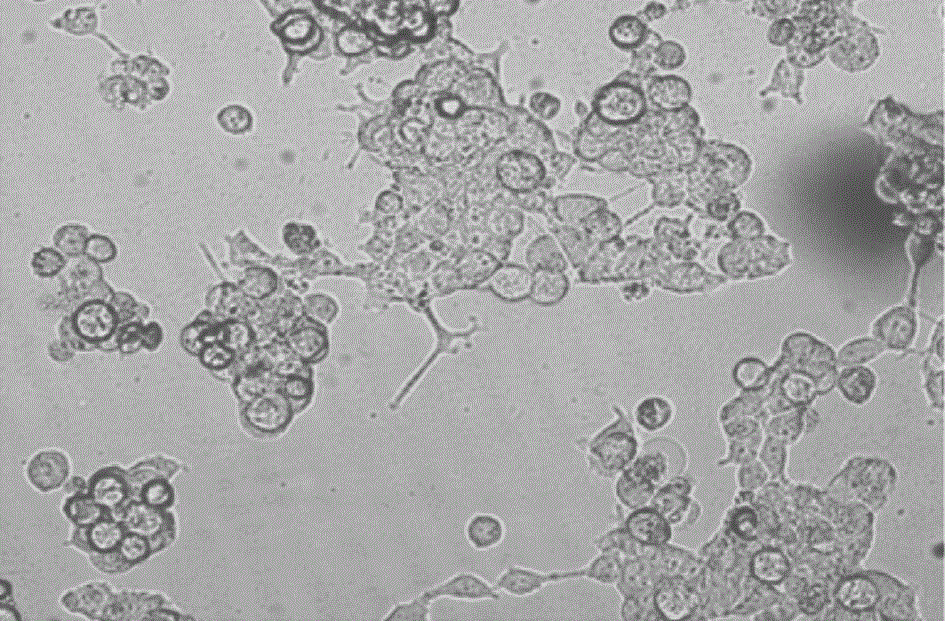TNFR1 gene recombinant adenovirus and construction thereof
A gene recombination, adenovirus technology, applied in the field of recombinant adenovirus, can solve problems such as unclear
- Summary
- Abstract
- Description
- Claims
- Application Information
AI Technical Summary
Problems solved by technology
Method used
Image
Examples
Embodiment 1
[0022] Design the siRNA sequence that interferes with the expression of TNFR1, specifically: 5'-attgttactaagcccctaact-3'.
[0023] The shRNA expression sequence containing the above siRNA was artificially synthesized, the sequence was connected to the sense strand and the antisense strand of the above siRNA through a loop of 7 bases, and BamHI and EcoRI restriction sites were respectively introduced at both ends of the sequence.
[0024] Topstrand (62bp):
[0025] 5'-AATTCGattgttactaagcccctaactTGTGCTTagttaggggcttagtaacaatTTTTTTg-3';
[0026] Bottomstrand (62bp):
[0027] 5'-GATCCAAAAAAAattgttactaagcccctaactAAGCACAagttaggggcttagtaacaatCg-3'.
[0028] The above-mentioned complementation utilizes 3' and 5' single-strand annealing to obtain the double-strand expression template annealing product of the corresponding target fragment shRNA. The annealing procedure is:
[0029] System: 20μl;
[0030] 10×Buffer2μl;
[0031] 100mM Tris-Cl pH7.5;
[0032] 1M NaCl;
[0033] 10mM ...
Embodiment 2
[0052] Take 2ml of the adenovirus shuttle plasmid bacterial solution in the logarithmic growth phase prepared in Example 1, add it to 100ml LB medium containing 100μg / ml Amp, shake the bacteria overnight at 37°C and 300rpm, and extract the plasmid with the Kangwei Century Zhongli Plasmid Kit .
[0053] The day before transfection, 293 cells were inoculated in 60 mm culture dishes, the medium was DMEM+10% Hyclon fetal bovine serum, and placed at 37°C with 5% CO 2 cultured overnight in an incubator.
[0054] When the cells grow to 70-80% of the bottom area, take the recombinant adenovirus vector plasmid TNFR1shRNA and the backbone plasmid pHBAd-BHG, and use Lipofiter TM Lipofectamine (Hanbio) transfection reagent was used for transfection.
[0055] The specific steps are:
[0056] a. Replace the complete medium 2 hours before transfection. Take 2 μg of recombinant adenovirus vector plasmid TNFR1shRNA and 4 μg of backbone plasmid pHBAd-BHG, dilute them with 300 μl of DMEM me...
Embodiment 3
[0066] At a density of 2×10 5 Plant the MEF cell line into a 6-well plate. After the cells grow to 60% confluence, they are infected with Ad-GFP and Ad-TNFR1shRNA adenovirus respectively, at 37°C and 5% CO 2 Cultivate in the incubator for 2 hours, replace the culture medium, and observe the fluorescent expression of GFP under a fluorescent microscope after culturing for 36 hours. The results are as follows: image 3 shown.
[0067] Collect the cells, wash them 3 times with PBS, scrape the cells with a scraper, transfer them into EP tubes, centrifuge at 1000rpm for 3 minutes, discard the supernatant, freeze the cell pellets with liquid nitrogen and store them in a -8°C refrigerator. Take out the cells from the -80°C refrigerator, add 500 μl RIPA Complete Lysis Solution, lyse on ice for 2 hours, centrifuge at 12,000 rpm for 30 minutes, collect the supernatant, and discard the precipitate. The protein content in the supernatant samples was determined by the BCA method, and the ...
PUM
 Login to View More
Login to View More Abstract
Description
Claims
Application Information
 Login to View More
Login to View More - R&D
- Intellectual Property
- Life Sciences
- Materials
- Tech Scout
- Unparalleled Data Quality
- Higher Quality Content
- 60% Fewer Hallucinations
Browse by: Latest US Patents, China's latest patents, Technical Efficacy Thesaurus, Application Domain, Technology Topic, Popular Technical Reports.
© 2025 PatSnap. All rights reserved.Legal|Privacy policy|Modern Slavery Act Transparency Statement|Sitemap|About US| Contact US: help@patsnap.com



